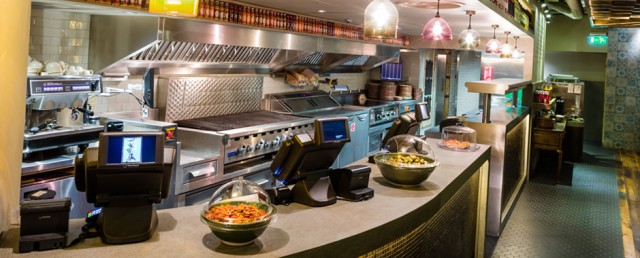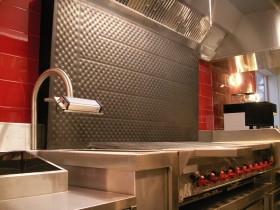
As cities seek to approach carbon neutrality (for instance, Copenhagen aims to be carbon neutral by 2025), making maximum use of every unit of energy is a primary goal. Often this means capturing a second use of ‘throwaway heat,’ as Con Ed has for decades in making steam for New York City buildings as a byproduct of generating plants. Cogeneration systems are becoming the norm on multiple scales, with NYU’s cogeneration system being another prominent New York example.
For a parallel effort in maximizing energy efficiency scaled to down to the size of a small business, a company has developed a way to capture and reuse excess heat from the operations of a single restaurant kitchen.
Commercial kitchens are well known for being major energy consumers. Between ovens, stoves, walk-in refrigerators, and dish-washers, large amounts of energy are constantly being exhausted in restaurants. Unfortunately, most of this energy is wasted. When refrigerated and frozen foods are heated up at a fast rate — typically over a stove top or in an oven — only a percentage of the total heat is actually being used on the foods being cooked. The underutilized, excess heat is then vented to the open air.
The slogan of Dext Heat Recovery is a quote from Albert Einstein, “energy cannot be created nor destroyed, it can only be changed from one form to another.” With this as their guide, the designers at Dext saw an opportunity in taking the wasted heat seen in restaurants and channeling it somewhere else that needed it: in this case, the water supply.
[youtube http://www.youtube.com/watch?v=rSXyEKlN3nU?feature=player_embedded&w=640&h=360]
By recovering the waste heat generated by the cooking process via the ‘heat recovery plates’ (shown above) and converting the heat to the water circuit, a kitchen can then use the recovered heat to meet the hot water demand of the restaurant. These ‘heat recovery plates’ are installed in strategic areas of the kitchen, such as directly behind a chargrill or within a canopy overhanging a stove, where they are able to absorb the greatest amount of excess heat. After it is captured, the  heat is then transferred to a buffer hot water cylinder, which is connected to the existing hot water cylinder. By pumping hot water from the buffer cylinder into the existing hot water cylinder, instead of from the mains water (which is typically always cold in temperature), less energy is needed to heat up the hot water cylinder, therefore providing recycled, more energy-efficient and cost-effective hot water for the restaurant!
heat is then transferred to a buffer hot water cylinder, which is connected to the existing hot water cylinder. By pumping hot water from the buffer cylinder into the existing hot water cylinder, instead of from the mains water (which is typically always cold in temperature), less energy is needed to heat up the hot water cylinder, therefore providing recycled, more energy-efficient and cost-effective hot water for the restaurant!
Images and media courtesy of Dext Heat Recovery.